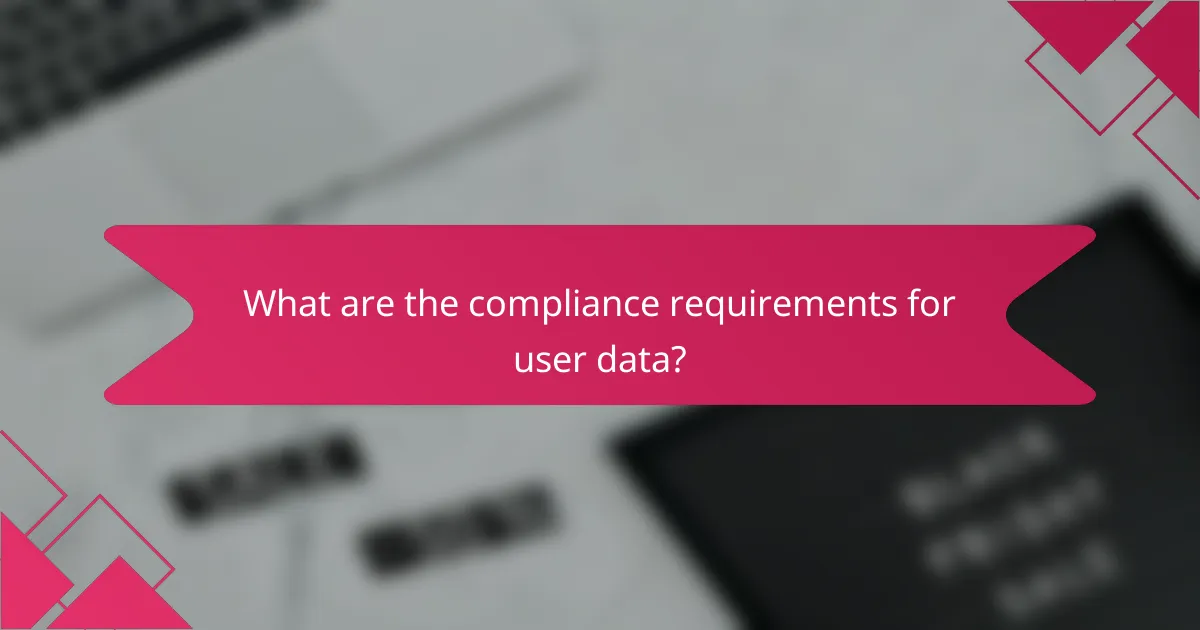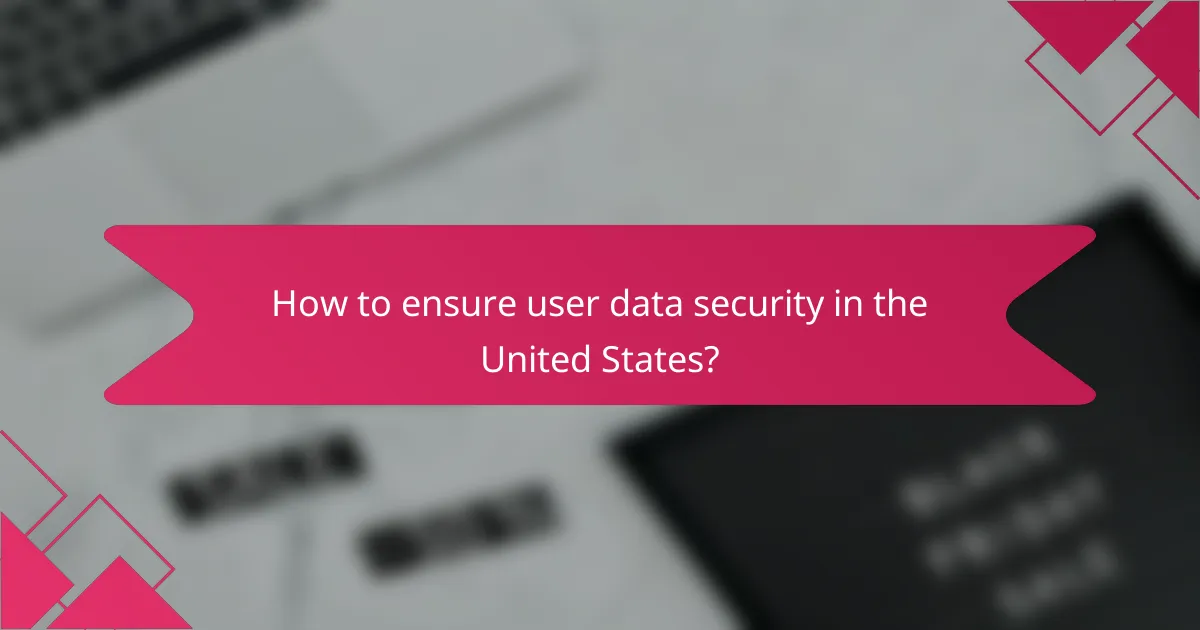In today’s digital landscape, responsible handling of user data is crucial for maintaining trust and compliance with regulations. Organizations must adopt best practices such as data minimization and encryption, while also developing a comprehensive data strategy that includes governance measures and lifecycle management. By prioritizing these elements, businesses can effectively protect sensitive information and navigate the complexities of compliance requirements.

What are the best practices for user data handling?
Best practices for user data handling focus on minimizing risk while ensuring compliance with regulations. Implementing effective strategies such as data minimization, encryption, access controls, regular audits, and user consent management is essential for protecting sensitive information.
Data minimization
Data minimization involves collecting only the information that is necessary for a specific purpose. This reduces the risk of exposure and simplifies compliance with data protection regulations like GDPR. For example, if an email address is sufficient for communication, avoid collecting additional personal details.
Organizations should regularly review their data collection practices to ensure they align with this principle. By limiting data collection, businesses can enhance user trust and reduce the potential impact of data breaches.
Encryption techniques
Encryption is a critical technique for safeguarding user data both in transit and at rest. Utilizing strong encryption algorithms, such as AES-256, ensures that even if data is intercepted, it remains unreadable without the proper decryption key. This is particularly important for sensitive information like financial details or personal identifiers.
Implementing encryption should be a standard practice in data handling strategies. Regularly updating encryption methods and training staff on secure data handling can further bolster security measures.
Access controls
Access controls determine who can view or use user data within an organization. Implementing role-based access control (RBAC) ensures that only authorized personnel can access sensitive information, thereby reducing the risk of internal breaches. Regularly reviewing access permissions is crucial to maintaining security.
Organizations should consider using multi-factor authentication (MFA) to enhance access security. This adds an additional layer of protection, making it harder for unauthorized users to gain access to sensitive data.
Regular audits
Conducting regular audits of data handling practices helps identify vulnerabilities and ensure compliance with relevant regulations. Audits should assess data storage, access controls, and encryption methods to ensure they meet established standards. This proactive approach can prevent potential data breaches and enhance overall data security.
Organizations should establish a routine schedule for audits, such as quarterly or biannually, depending on the volume of data processed. Documenting findings and implementing corrective actions is essential for continuous improvement.
User consent management
User consent management involves obtaining and managing user permissions for data collection and processing. Clear and transparent consent forms should be provided, outlining what data is collected and how it will be used. This practice not only complies with regulations but also builds trust with users.
Organizations should implement systems to track consent and allow users to easily withdraw their consent when desired. Regularly updating consent management practices in line with changing regulations is vital for maintaining compliance and user confidence.

How to develop a user data strategy?
Developing a user data strategy involves defining clear objectives, identifying reliable data sources, implementing governance measures, and managing the data lifecycle effectively. This structured approach ensures compliance with regulations and enhances data utility for decision-making.
Define data objectives
Start by setting specific goals for your user data strategy. Objectives could include improving customer experience, increasing retention rates, or enhancing product development. Clearly defined objectives guide your data collection and usage, ensuring alignment with business priorities.
Consider using the SMART criteria—specific, measurable, achievable, relevant, and time-bound—to refine your objectives. For example, instead of a vague goal like “understand users better,” specify “increase user engagement by 20% over the next six months through targeted marketing.”
Identify data sources
Identifying data sources is crucial for gathering relevant user information. Sources can include customer surveys, website analytics, social media interactions, and transaction records. Each source provides unique insights that contribute to a comprehensive understanding of user behavior.
Evaluate the reliability and quality of each data source. For instance, while social media data can provide real-time insights, it may not always reflect the entire user base accurately. Combining multiple sources often yields a more balanced view.
Implement data governance
Data governance involves establishing policies and procedures for managing user data responsibly. This includes defining roles, responsibilities, and standards for data access, usage, and security. Effective governance helps mitigate risks associated with data breaches and non-compliance.
Consider adopting frameworks such as the General Data Protection Regulation (GDPR) in Europe or the California Consumer Privacy Act (CCPA) in the U.S. These regulations provide guidelines for data handling and user privacy, ensuring your strategy remains compliant.
Establish data lifecycle management
Data lifecycle management refers to the process of managing data from its creation to its deletion. This includes data collection, storage, usage, sharing, and eventual disposal. Establishing a clear lifecycle helps maintain data quality and compliance with regulations.
Implement policies for regular data audits and reviews to ensure data remains relevant and secure. For example, set a schedule for archiving or deleting data that is no longer needed, thereby reducing storage costs and minimizing risks associated with outdated information.

What are the compliance requirements for user data?
Compliance requirements for user data involve adhering to various regulations that protect personal information. Organizations must understand and implement these standards to avoid legal penalties and ensure user trust.
GDPR compliance
The General Data Protection Regulation (GDPR) is a comprehensive data protection law in the European Union. It mandates that organizations obtain explicit consent from users before processing their personal data and provides individuals with rights such as data access, rectification, and erasure.
To comply with GDPR, businesses should implement data protection by design and by default, conduct regular data audits, and appoint a Data Protection Officer if necessary. Non-compliance can result in fines amounting to millions of euros or a percentage of annual global turnover.
CCPA regulations
The California Consumer Privacy Act (CCPA) grants California residents specific rights regarding their personal data, including the right to know what data is collected, the right to delete data, and the right to opt-out of data sales. Businesses must inform consumers about these rights and provide clear privacy notices.
To comply with CCPA, organizations should establish processes for handling consumer requests and ensure transparency in data collection practices. Non-compliance can lead to fines ranging from $2,500 to $7,500 per violation.
HIPAA considerations
The Health Insurance Portability and Accountability Act (HIPAA) sets standards for protecting sensitive patient information in the healthcare sector. Covered entities must ensure the confidentiality, integrity, and availability of protected health information (PHI).
To comply with HIPAA, healthcare organizations should implement administrative, physical, and technical safeguards. Regular training for employees on data handling practices is essential to mitigate risks of data breaches and ensure compliance.
Data breach notification laws
Data breach notification laws require organizations to inform affected individuals and relevant authorities when personal data breaches occur. The specifics can vary by jurisdiction, but timely notification is generally mandated to minimize potential harm.
To comply with these laws, businesses should have a clear incident response plan that includes procedures for identifying breaches, assessing risks, and notifying affected parties within specified timeframes. Failure to notify can lead to significant legal repercussions and damage to reputation.

How to ensure user data security in the United States?
To ensure user data security in the United States, organizations must implement a combination of technical measures, employee training, and incident response strategies. This multi-faceted approach helps protect sensitive information from breaches and complies with relevant regulations.
Use of firewalls
Firewalls act as a barrier between trusted internal networks and untrusted external networks, controlling incoming and outgoing traffic. Implementing both hardware and software firewalls can significantly reduce the risk of unauthorized access to user data.
Regularly updating firewall rules and configurations is crucial. Organizations should conduct periodic reviews to ensure that only necessary ports and protocols are open, minimizing potential vulnerabilities.
Regular security training
Regular security training for employees is essential for maintaining user data security. Training should cover topics such as phishing awareness, password management, and safe internet practices to empower staff to recognize and respond to threats.
Consider conducting training sessions at least quarterly, supplemented by simulated phishing attacks to gauge employee awareness. This proactive approach helps create a security-conscious culture within the organization.
Incident response plans
An effective incident response plan outlines the steps to take when a data breach occurs. This plan should include roles and responsibilities, communication protocols, and recovery procedures to minimize damage and restore operations quickly.
Regularly testing and updating the incident response plan is vital. Conduct tabletop exercises to simulate potential breaches and refine the response strategy, ensuring that all team members are familiar with their roles during an actual incident.

What tools can assist with user data management?
Several tools can enhance user data management by streamlining compliance, analytics, and overall data governance. These tools help organizations effectively handle user data while adhering to regulations and maximizing insights.
OneTrust for compliance
OneTrust is a leading platform designed to assist organizations in managing compliance with data protection regulations such as GDPR and CCPA. It offers features for data mapping, impact assessments, and consent management, ensuring that user data is handled according to legal requirements.
When using OneTrust, consider integrating it with existing systems to automate data collection and reporting. This can reduce manual errors and save time, allowing for more efficient compliance workflows. Regularly updating your compliance practices within the platform is crucial to adapt to changing regulations.
DataRobot for analytics
DataRobot is an advanced analytics platform that enables organizations to leverage user data for predictive modeling and insights. It automates the machine learning process, allowing users to analyze trends and patterns without needing extensive data science expertise.
To maximize the benefits of DataRobot, focus on defining clear objectives for your analytics projects. Start with a well-structured dataset and utilize the platform’s automated features to explore various models. Regularly review the outcomes to refine your strategies and ensure alignment with business goals.










